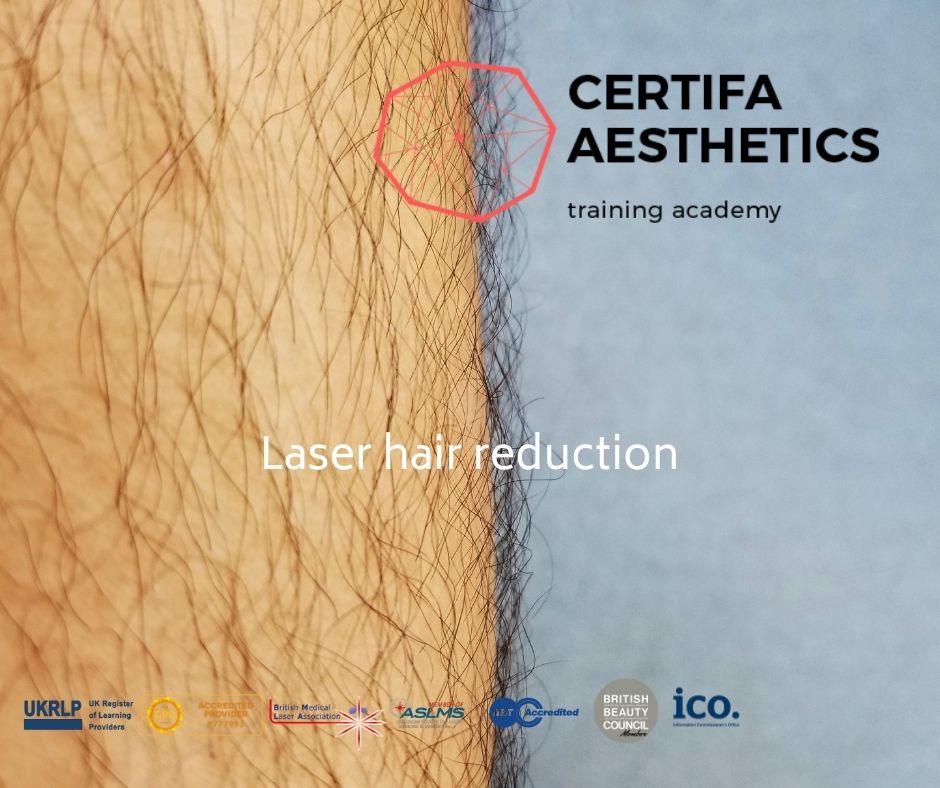Hair reduction- laser or IPL?

In this article you will find out:
- How light works in epilation treatments.
- What is the difference between IPL and laser.
- What lasers are used in epilation.
- Which means permanent hair reduction.
- Which is more effective – laser or IPL.
Epilation with the use of lasers and IPL (Intensive Pulsed Light) devices has become one of the most popular treatments. In my daily practice, I often meet patients who previously used various methods of removing unwanted hair, and recently more and more patients report performing treatments at home using IPL devices for home use.
Lasers and IPL devices are based on the theory of selective photothermolysis, where light is absorbed by the melanin in the hair follicle and the energy is then converted into heat to damage the hair papilla. However, there are fundamental differences in the method of construction and the light emitted between laser and IPL.
- Laser (Light Amplification by Stimulated Emission of Radiation) emits monochromatic, focused, coherent light with a significant power density.
- IPL emits pulsating polychromatic, diffused, incoherent light.
Epilation as permanent removal of unwanted hair with lasers and IPL has been the subject of many scientific papers, including my cohort study on the use of diode lasers for epilation in various ethnic groups [1]
In this article, I will refer to the effectiveness of epilation treatments with lasers and IPL devices.
Unwanted hair is a frequently reported problem. Traditional hair removal methods include shaving, bleaching, plucking, waxing, the use of chemical and mechanical depilatories, and electrolysis. These techniques are slowly being replaced by their limitations such as pain or ineffectiveness.
Diode lasers have proven to be safe and effective devices for hair reduction on all skin types and ethnicities [2-4] and thus have been recognized as the gold standard in unwanted hair removal treatments. Since the introduction of IPL devices in the 90s of the twentieth century, they have been eagerly used by professionals as an alternative to lasers.
The first laser used for epilation was Ruby lasers with a wavelength of 693 nm. Treatments with its use required a lot of time and it was effective only for clients with light skin type and perfectly dark, thick hair.
An Alexandrite laser with a wavelength of 755 nm soon appeared on the market. In practice, this laser was faster, but the skin phototype was still a limitation – this laser was effective for phototypes I-III.
The Nd: Yag laser is a laser effectively used for clients with darker phototypes for hair epilation, and due to the wavelength of 1064 nm, it is successfully used in procedures, e.g. closing vessels, most of the phototype.
Diode lasers – the gold standard in hair epilation. They are effective in any phototype! in addition, for manufacturers diodes – as semiconductors are inexpensive and allow you to adjust the wavelength. It is for this reason that we often see a diode laser with a wavelength of 805, 808 or 810 nm. Recently, lasers in diode technology are also popular on the market, but they operate at wavelengths characteristic, for example, for Alexander or Nd Yag lasers.
IPL devices have been used as an alternative to laser hair removal since the 1990s, when they were introduced to the market. In fact, these devices offer many therapeutic possibilities with the use of appropriate optical filters. However, probably due to the nature of light, IPLs are less selective, so they require more treatments to achieve the desired hair reduction results.
Since home appliances appeared on the market, such as: iPulse Personal (CyDen Ltd, UK), Silk’n (Home Skinovations Ltd, Israel), No! No! (Radiancy Inc., USA) and Teny Epil Flash (GHT Innovation, France) and others, which can be purchased directly from the manufacturer in China or Korea. They aroused interest among patient-consumers, for whom they were often the first choice of treatments for financial reasons.
Moreover, the use at home and at any time seemed very attractive. However, often due to the lack of patient-consumer awareness, the lack of satisfactory results, the need for frequent use, the length of each treatment or the occurrence of burns, the use of these devices causes disappointment and frustration. Additionally, the safety of users, which is always related to their awareness and education, should be taken into account in the first place [5].
What is worth remembering is the fact that in order to obtain optimal hair reduction results, you should know the basic treatment parameters and remember to be careful about the possibility of injuring the body and eyes when using lasers or IPL devices. This is not troublesome for professionals, however, it may be debatable for their patients who have previously used IPL at home. For this reason, it is necessary to educate and increase the awareness of users of self-oscillating IPL hair reduction devices.
Permanent hair reduction by definition refers to a noticeable, sustained reduction in the number of hairs over a period longer than the full hair growth cycle. It is worth pointing out that this does not mean total hair loss, but rather no hair regrowth and a reduction in the total number of hairs in the treatment area. [6,7]
A comparison of diode laser effectiveness and IPL hair reduction studies can be found. Chen, J., Liu, X. and Huo, M. in a 2012 study [8] found that low power diode lasers and IPL devices had similar results.
As I suspect in this study, when diode laser treatments are followed by home IPL treatments, the diode laser results will be weaker compared to the control group where only the diode laser treatments will be performed.
As shown by Ormiga P, C. Ishida C, Boechat A, Ramos E and Silva M in 2104 [9], both IPL for professional use and the diode laser are effective, but the diode laser shows more results in hair reduction.
In the article by Magdalena Atta-Motte and Izabela Zaleska on the impact of IPL devices on the effectiveness of the later used diode laser [10], published in 2021, it was shown that the results of the percentage hair loss only with the use of a diode laser were better than in the area where previously IPL was applied. Moreover, the results with the diode laser were better than with the IPL device.
Similar results were obtained by Hayder RH, Anmar ZS and Zahra AR in 2015 [11] in a split-face diode laser and IPL study for professional use. Both studies have shown that the diode laser is less painful than using a professional IPL.
Conclusions:
- Diode lasers are the gold standard in epilation
- Diode lasers are more effective than IPL
- Treatments with diode lasers are less painful.
- The use of IPL before treatments with diode lasers negatively affects the operation of diode lasers
- IPL is less effective.
I cordially invite you to take part in the Laser/ IPL hair reduction course
https://certifa-aesthetics.com/course/laser-ipl-treatments-for-hair-reduction/
email us: info@certifa-aesthetics.com
References:
1) Atta-Motte M, Załęska I. Diode Laser 805 Hair Removal Side Effects in Groups of Various Ethnicities – Cohort Study Results. J Lasers Med Sci. 2020 Spring;11(2):132-137. doi: 10.34172/jlms.2020.23. Epub 2020 Mar 15. PMID: 32273953; PMCID: PMC7118507.
2) Jo SJ, Kim J, Ban J, Lee Y, Kwon O and Koh W. Efficacy and Safety of Hair Removal with a Long-Pulsed Diode Laser Depending on the Spot Size: A Randomized, Evaluators-Blinded, Left-Right Study. Ann Dermatol. 2015; pp. 27(5):517-22.
3) Atta-Motte M, Załęska, I. Effectiveness of diode laser 805 nm in pubic hair removal in groups of various ethnicity. Pol J Cosmetol. 2018; 21(2): 177-183
4) Załęska I., & Atta-Motte M. Aspects of Diode Laser (805 nm) Hair Removal Safety in a Mixed-Race Group of Patients. Journal of Lasers in Medical Sciences. 2019; 10(2), 146-152.
5) Town G, Ash C. Measurement of home-use laser and intense pulsed light systems for hair removal: preliminary report. J Cosmet Laser Ther. 2009 Sep;11(3):157-68. doi: 10.1080/14764170903137113.
6) Dierickx CC. Hair removal by lasers and intense pulsed light sources. Semin Cutan Med Surg. 2000 Dec;19(4):267-75.
7) Anderson RR, Parrish A. Selective photothermolysis: Precise microsurgery by selective absorption of pulsed radiation. Science. 1983; 220:524-527.
8) Chen, J. , Liu, X. and Huo, M. Split‐leg comparison of low fluence diode laser and high fluence intense pulsed light in permanent hair reduction in skin types III to IV. Australasian Journal of Dermatology. 2012; 53: 186-189.
9) Ormiga P, C. Ishida C, Boechat A, Ramos E and Silva M. Comparison of the effect of diode laser versus intense pulsed light in axillary hair removal. Dermatol Surg. 2014; pp. 40(10):1061-9.
10) Atta-Motte M, Zaleska I. The results of the diode laser hair reduction treatments after the IPL hair reduction treatments. J Cosmet Laser Ther. 2020 Nov 16;22(6-8):265-270. doi: 10.1080/14764172.2021.1936066. Epub 2021 Jun 9. PMID: 34107828.
11) Hayder RH, Anmar ZS and Zahra AR. Evaluation of Effectiveness of Diode Laser System (808 nm) versus Intense Pulse Light(IPL) in the Management of Unwanted Hair: A Split Face Comparative Study. International Journal of Medical Physic, Clinical Engineering, and Radiation Oncology. 2015; pp. 4, 41-48,






